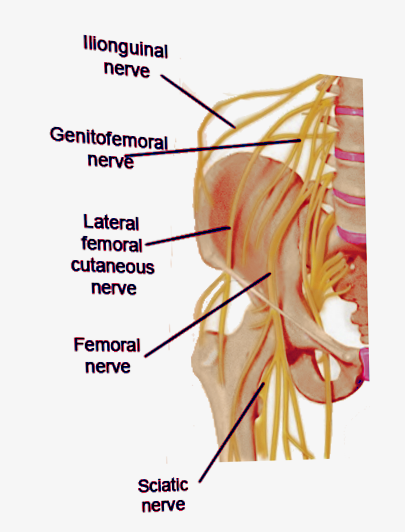[1]
Starling JR, Harms BA. Diagnosis and treatment of genitofemoral and ilioinguinal neuralgia. World journal of surgery. 1989 Sep-Oct:13(5):586-91
[PubMed PMID: 2815802]
[2]
Ndiaye A, Diop M, Ndoye JM, Konaté I, Ndiaye AI, Mané L, Nazarian S, Dia A. Anatomical basis of neuropathies and damage to the ilioinguinal nerve during repairs of groin hernias. (about 100 dissections). Surgical and radiologic anatomy : SRA. 2007 Dec:29(8):675-81
[PubMed PMID: 17985072]
[3]
Cho HM, Park DS, Kim DH, Nam HS. Diagnosis of Ilioinguinal Nerve Injury Based on Electromyography and Ultrasonography: A Case Report. Annals of rehabilitation medicine. 2017 Aug:41(4):705-708. doi: 10.5535/arm.2017.41.4.705. Epub 2017 Aug 31
[PubMed PMID: 28971057]
Level 3 (low-level) evidence
[4]
Whiteside JL, Barber MD, Walters MD, Falcone T. Anatomy of ilioinguinal and iliohypogastric nerves in relation to trocar placement and low transverse incisions. American journal of obstetrics and gynecology. 2003 Dec:189(6):1574-8; discussion 1578
[PubMed PMID: 14710069]
[5]
Kim DH, Murovic JA, Tiel RL, Kline DG. Surgical management of 33 ilioinguinal and iliohypogastric neuralgias at Louisiana State University Health Sciences Center. Neurosurgery. 2005 May:56(5):1013-20; discussion 1013-20
[PubMed PMID: 15854249]
[6]
Starling JR, Harms BA, Schroeder ME, Eichman PL. Diagnosis and treatment of genitofemoral and ilioinguinal entrapment neuralgia. Surgery. 1987 Oct:102(4):581-6
[PubMed PMID: 3660235]
[7]
Toussaint CP, Perry EC 3rd, Pisansky MT, Anderson DE. What's new in the diagnosis and treatment of peripheral nerve entrapment neuropathies. Neurologic clinics. 2010 Nov:28(4):979-1004. doi: 10.1016/j.ncl.2010.03.017. Epub
[PubMed PMID: 20816274]
[8]
Hahn L. Treatment of ilioinguinal nerve entrapment - a randomized controlled trial. Acta obstetricia et gynecologica Scandinavica. 2011 Sep:90(9):955-60. doi: 10.1111/j.1600-0412.2011.01194.x. Epub 2011 Jun 27
[PubMed PMID: 21615360]
Level 1 (high-level) evidence
[10]
ter Meulen BC, Peters EW, Wijsmuller A, Kropman RF, Mosch A, Tavy DL. Acute scrotal pain from idiopathic ilioinguinal neuropathy: diagnosis and treatment with EMG-guided nerve block. Clinical neurology and neurosurgery. 2007 Jul:109(6):535-7
[PubMed PMID: 17481807]
[11]
Gofeld M, Christakis M. Sonographically guided ilioinguinal nerve block. Journal of ultrasound in medicine : official journal of the American Institute of Ultrasound in Medicine. 2006 Dec:25(12):1571-5
[PubMed PMID: 17121952]
[12]
Bay-Nielsen M, Perkins FM, Kehlet H, Danish Hernia Database. Pain and functional impairment 1 year after inguinal herniorrhaphy: a nationwide questionnaire study. Annals of surgery. 2001 Jan:233(1):1-7
[PubMed PMID: 11141218]
[13]
Lichtenstein IL, Shulman AG, Amid PK, Montllor MM. Cause and prevention of postherniorrhaphy neuralgia: a proposed protocol for treatment. American journal of surgery. 1988 Jun:155(6):786-90
[PubMed PMID: 3377120]
[14]
Eichenberger U, Greher M, Kirchmair L, Curatolo M, Moriggl B. Ultrasound-guided blocks of the ilioinguinal and iliohypogastric nerve: accuracy of a selective new technique confirmed by anatomical dissection. British journal of anaesthesia. 2006 Aug:97(2):238-43
[PubMed PMID: 16698865]
[15]
Rosen MJ, Novitsky YW, Cobb WS, Kercher KW, Heniford BT. Combined open and laparoscopic approach to chronic pain following open inguinal hernia repair. Hernia : the journal of hernias and abdominal wall surgery. 2006 Mar:10(1):20-4
[PubMed PMID: 16501867]
[16]
Knockaert DC, D'Heygere FG, Bobbaers HJ. Ilioinguinal nerve entrapment: a little-known cause of iliac fossa pain. Postgraduate medical journal. 1989 Sep:65(767):632-5
[PubMed PMID: 2608591]
[17]
Antman EM. Evaluating the Cardiovascular Safety of Nonsteroidal Anti-Inflammatory Drugs. Circulation. 2017 May 23:135(21):2062-2072. doi: 10.1161/CIRCULATIONAHA.117.027288. Epub
[PubMed PMID: 28533319]
[18]
Shin S. Safety of celecoxib versus traditional nonsteroidal anti-inflammatory drugs in older patients with arthritis. Journal of pain research. 2018:11():3211-3219. doi: 10.2147/JPR.S186000. Epub 2018 Dec 14
[PubMed PMID: 30588073]
[19]
García-Rayado G, Navarro M, Lanas A. NSAID induced gastrointestinal damage and designing GI-sparing NSAIDs. Expert review of clinical pharmacology. 2018 Oct:11(10):1031-1043. doi: 10.1080/17512433.2018.1516143. Epub 2018 Sep 20
[PubMed PMID: 30139288]
[21]
Jeng CL, Torrillo TM, Rosenblatt MA. Complications of peripheral nerve blocks. British journal of anaesthesia. 2010 Dec:105 Suppl 1():i97-107. doi: 10.1093/bja/aeq273. Epub
[PubMed PMID: 21148659]
[22]
Rosario DJ, Jacob S, Luntley J, Skinner PP, Raftery AT. Mechanism of femoral nerve palsy complicating percutaneous ilioinguinal field block. British journal of anaesthesia. 1997 Mar:78(3):314-6
[PubMed PMID: 9135313]
[23]
Jöhr M, Sossai R. Colonic puncture during ilioinguinal nerve block in a child. Anesthesia and analgesia. 1999 May:88(5):1051-2
[PubMed PMID: 10320167]
[24]
Vaisman J. Pelvic hematoma after an ilioinguinal nerve block for orchialgia. Anesthesia and analgesia. 2001 Apr:92(4):1048-9
[PubMed PMID: 11273948]
[25]
Drakonaki EE, Adriaensen MEAPM, Al-Bulushi HIJ, Koliarakis I, Tsiaoussis J, Vanderdood K. Sonoanatomy of the ilioinguinal, iliohypogastric, genitofemoral, obturator, and pudendal nerves: a practical guide for US-guided injections. Journal of ultrasonography. 2022 Mar:22(88):e44-e50. doi: 10.15557/JoU.2022.0008. Epub 2022 Feb 8
[PubMed PMID: 35449704]


